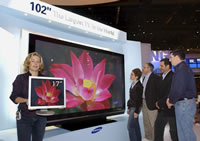In what has now become a tradition, Bill Gates opened the Consumer Electronics Show (CES) in Las Vegas extolling the virtues of Digital Lifestyles (thanks for the plug Bill).
In a “casual” interview style, US TV chat show presenter, Conan O’Brien, lead Bill through the wonderful world of digital media.
O’Brien started his shtick with a great joke, “When Bill Gates walks onto this stage in a few minutes, the average net worth of each person in this room will be(come) $128 million.”. He then went on to be reasonably rude about most people in the industry. Of particular note was the “CES – The Movie” spoof casting, where well known characters in the industry were matched up with their acting doubles. It’s worth watching, just fire it up and jump to 11m 30s.
Bill Gates then came on stage to give Microsoft’s view of Digital Lifestyles.
Not surprisingly Microsoft pitches the PC as the centre of it, “The PC has a central role to play, (in that) it’s where it all comes together.”
As has been the case since the public started recognising the iPod and iTunes, Bill and his promotional videos took every opportunity to feature ‘other’ music players, while subtly highlighting the virtues of the Microsoft approach.
This covered “Windows Plays For Sure”, the certification process that labels all devices that are able to understand and adhere to Microsoft’s Digital Rights Management (DRM) scheme. Read as, music in Apple’s format can’t play on other devices except Apples.
For the trend spotters among you, Bill referred to this as a “rights management system”, dropping the Digital prefix.
He also pitched monthly subscription services where you have access to all of the music you desire – another thing that Apple iTunes doesn’t offer. He failed to mention that with most subscriptions services, the ability to play the music you’ve paid for access to, stops when the monthly subscriptions fees do.
Media Centre featured large with Gates announcing that PC manufacturers have sold 1.4 million Media Centre models worldwide so far.
Media Extenders, which enables households with networked homes to pull content from their Media Centres to rooms around the house were also brought up again. Dedicated boxes from companies like LG were mentioned as well as a software upgrade for Microsoft’s xBox to provide the same function. The fact that 6.3 million people had bought Halo 2, was also dropped into the conversation.
The LG example was of note. A dedicated DVR with DVD burner, it featured a cut-down version of the Media Center software that retained the familiar user interface (UI), while offering access to music and photo’s stored on the Media Centre PC. Not only that but content recorded on this dedicated device could be transferred to the Media Centre PC and in turn to a smartphone or Portable Media Centre (PMC).
To easily operate the Media Centre, the “simple, single remote control” was also touted, more than once. Microsoft have formed partnerships with Philips, NiveusMedia and Logitech to produce universal remote controls that work with Media Centre, as well as many other devices. All these remotes will feature a “signature” Green Start button. Bill had previously mentioned that some remote controls will have small colour screens on them, allowing video content to be shown on them.
New content partners also got a nod. Discovery will be creating “unique content” that fits on Media Center, with Yahoo and Fox Sports also getting a mention.
One key item was the launch of the Media Centre as a platform. Not just a means of accessing and playing back content, but of broadcasters creating interactive content specifically for it, that combines broadcast and IP delivered content using Online Spotlight. We feel this is the most important item to come out and will be covered in more detail in another piece shortly.
It’s also worth watching the video, if nothing else then to see Bill looking less than comfortable with the interview technique.
Bill Gates CES – Opening Speech
 Samsung is showing a 102-inch Plasma Display Panel (PDP) TV at CES. Currently standing as the worlds largest TV, they’re upping the ante of their own 80-inch screen they announced back in January last year.
Samsung is showing a 102-inch Plasma Display Panel (PDP) TV at CES. Currently standing as the worlds largest TV, they’re upping the ante of their own 80-inch screen they announced back in January last year.  Today Electronic Arts (EA) used CES to announce its line-up for the US launch of Sony’s handheld entertainment system, the PSP due in March.
Today Electronic Arts (EA) used CES to announce its line-up for the US launch of Sony’s handheld entertainment system, the PSP due in March.  SIRIUS Satellite Radio announced today that it will be providing 2-3 channels of premium video content, designed primarily for children, in the second half of 2006, to be beamed into moving vehicles. They will be working with Microsoft to develop the service.
SIRIUS Satellite Radio announced today that it will be providing 2-3 channels of premium video content, designed primarily for children, in the second half of 2006, to be beamed into moving vehicles. They will be working with Microsoft to develop the service.  In an effort to keep up with the demands of the ever growing appetite for digital storage, Hitachi has announced a 500-Gigabyte drive.
In an effort to keep up with the demands of the ever growing appetite for digital storage, Hitachi has announced a 500-Gigabyte drive.  It’s not that we’re surprised by this news, but it did send a ripple of laughter around the Digital Lifestyles offices today.
It’s not that we’re surprised by this news, but it did send a ripple of laughter around the Digital Lifestyles offices today.